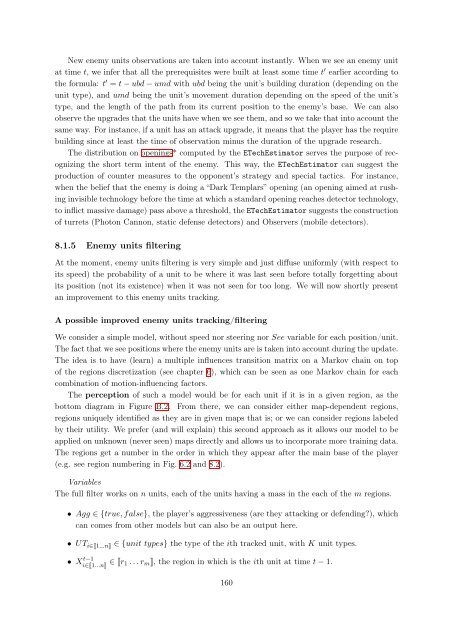Bayesian Programming and Learning for Multi-Player Video Games ...
Bayesian Programming and Learning for Multi-Player Video Games ...
Bayesian Programming and Learning for Multi-Player Video Games ...
Create successful ePaper yourself
Turn your PDF publications into a flip-book with our unique Google optimized e-Paper software.
New enemy units observations are taken into account instantly. When we see an enemy unit<br />
at time t, we infer that all the prerequisites were built at least some time t ′ earlier according to<br />
the <strong>for</strong>mula: t ′ = t − ubd − umd with ubd being the unit’s building duration (depending on the<br />
unit type), <strong>and</strong> umd being the unit’s movement duration depending on the speed of the unit’s<br />
type, <strong>and</strong> the length of the path from its current position to the enemy’s base. We can also<br />
observe the upgrades that the units have when we see them, <strong>and</strong> so we take that into account the<br />
same way. For instance, if a unit has an attack upgrade, it means that the player has the require<br />
building since at least the time of observation minus the duration of the upgrade research.<br />
The distribution on openings* computed by the ETechEstimator serves the purpose of recognizing<br />
the short term intent of the enemy. This way, the ETechEstimator can suggest the<br />
production of counter measures to the opponent’s strategy <strong>and</strong> special tactics. For instance,<br />
when the belief that the enemy is doing a “Dark Templars” opening (an opening aimed at rushing<br />
invisible technology be<strong>for</strong>e the time at which a st<strong>and</strong>ard opening reaches detector technology,<br />
to inflict massive damage) pass above a threshold, the ETechEstimator suggests the construction<br />
of turrets (Photon Cannon, static defense detectors) <strong>and</strong> Observers (mobile detectors).<br />
8.1.5 Enemy units filtering<br />
At the moment, enemy units filtering is very simple <strong>and</strong> just diffuse uni<strong>for</strong>mly (with respect to<br />
its speed) the probability of a unit to be where it was last seen be<strong>for</strong>e totally <strong>for</strong>getting about<br />
its position (not its existence) when it was not seen <strong>for</strong> too long. We will now shortly present<br />
an improvement to this enemy units tracking.<br />
A possible improved enemy units tracking/filtering<br />
We consider a simple model, without speed nor steering nor See variable <strong>for</strong> each position/unit.<br />
The fact that we see positions where the enemy units are is taken into account during the update.<br />
The idea is to have (learn) a multiple influences transition matrix on a Markov chain on top<br />
of the regions discretization (see chapter 6), which can be seen as one Markov chain <strong>for</strong> each<br />
combination of motion-influencing factors.<br />
The perception of such a model would be <strong>for</strong> each unit if it is in a given region, as the<br />
bottom diagram in Figure B.2. From there, we can consider either map-dependent regions,<br />
regions uniquely identified as they are in given maps that is; or we can consider regions labeled<br />
by their utility. We prefer (<strong>and</strong> will explain) this second approach as it allows our model to be<br />
applied on unknown (never seen) maps directly <strong>and</strong> allows us to incorporate more training data.<br />
The regions get a number in the order in which they appear after the main base of the player<br />
(e.g. see region numbering in Fig. 6.2 <strong>and</strong> 8.2).<br />
Variables<br />
The full filter works on n units, each of the units having a mass in the each of the m regions.<br />
• Agg ∈ {true, false}, the player’s aggressiveness (are they attacking or defending?), which<br />
can comes from other models but can also be an output here.<br />
• UT i∈�1...n� ∈ {unit types} the type of the ith tracked unit, with K unit types.<br />
• X t−1<br />
i∈�1...n� ∈ �r1 . . . rm�, the region in which is the ith unit at time t − 1.<br />
160


